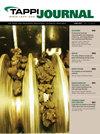Kraft pulp viscosity as a predictor of paper strength: Its uses and abuses
IF 0.6
4区 农林科学
Q4 MATERIALS SCIENCE, PAPER & WOOD
引用次数: 0
Abstract
For bleached kraft pulps, two factors govern paper strength: the individual fiber strength, and the bond strength that adheres the individual fibers together in the paper matrix. Inherent fiber strength is related to the length of the carbohydrate polymers, also known as the degree of polymerization (DP). Average DP (DP) is inferred by performing pulp viscosity measurements. Under certain circumstances during kraft pulping and bleaching, the average polymer lengths can be shortened, resulting in lower pulp viscosity, and may indicate fiber damage. Fiber damage typically manifests itself as a reduction in tear strength for well-bonded handsheets. This paper will review the literature on how pulp viscosity can predict paper/fiber strength and how it can be used as a diagnostic tool. It can be a means to monitor pulp quality during pulping and bleaching, as well as to alert when such operations approach a critical threshold. However, viscosity losses must be carefully and judiciously analyzed. Like most diagnostic tools, viscosity measurements can be misused and abused, which can lead to incorrect inferences about intrinsic fiber strength. This review will also cover these misuses. The overall goal is to provide the papermaker a better understanding of what pulp viscosity is, how it correlates to potential sheet strength, and what its limitations are. It will be illustrated that when pulp viscosity drops below a critical value, it will indicate an appreciable deterioration in the paper’s tear and tensile strength.硫酸盐浆粘度作为纸张强度的预测指标:它的用途和弊端
对于漂白的牛皮纸纸浆,有两个因素决定纸张的强度:单个纤维的强度和将单个纤维在纸基体中粘合在一起的粘合强度。纤维的固有强度与碳水化合物聚合物的长度有关,也称为聚合度(DP)。平均DP (DP)是通过执行纸浆粘度测量来推断的。在硫酸盐制浆和漂白过程中,在某些情况下,聚合物的平均长度会缩短,导致纸浆粘度降低,这可能表明纤维受损。纤维损伤通常表现为粘结良好的手板撕裂强度的降低。本文将回顾有关纸浆粘度如何预测纸/纤维强度以及如何将其用作诊断工具的文献。它可以在制浆和漂白过程中监测纸浆质量,并在这些操作接近临界阈值时发出警报。然而,粘度损失必须仔细和审慎地分析。像大多数诊断工具一样,粘度测量可能被误用和滥用,这可能导致对纤维固有强度的错误推断。本文也将讨论这些误用。总的目标是提供造纸一个更好的了解纸浆粘度是什么,它是如何关联到潜在的纸张强度,以及它的局限性是什么。将说明,当纸浆粘度降至临界值以下时,将表明纸张的撕裂和拉伸强度明显恶化。
本文章由计算机程序翻译,如有差异,请以英文原文为准。
求助全文
约1分钟内获得全文
求助全文
来源期刊

Tappi Journal
工程技术-材料科学:纸与木材
CiteScore
1.30
自引率
16.70%
发文量
59
审稿时长
6-12 weeks
期刊介绍:
An internationally recognized technical publication for over 60 years, TAPPI Journal (TJ) publishes the latest and most relevant research on the forest products and related industries. A stringent peer-review process and distinguished editorial board of academic and industry experts set TAPPI Journal apart as a reliable source for impactful basic and applied research and technical reviews.
Available at no charge to TAPPI members, each issue of TAPPI Journal features research in pulp, paper, packaging, tissue, nonwovens, converting, bioenergy, nanotechnology or other innovative cellulosic-based products and technologies. Publishing in TAPPI Journal delivers your research to a global audience of colleagues, peers and employers.
 求助内容:
求助内容: 应助结果提醒方式:
应助结果提醒方式:


